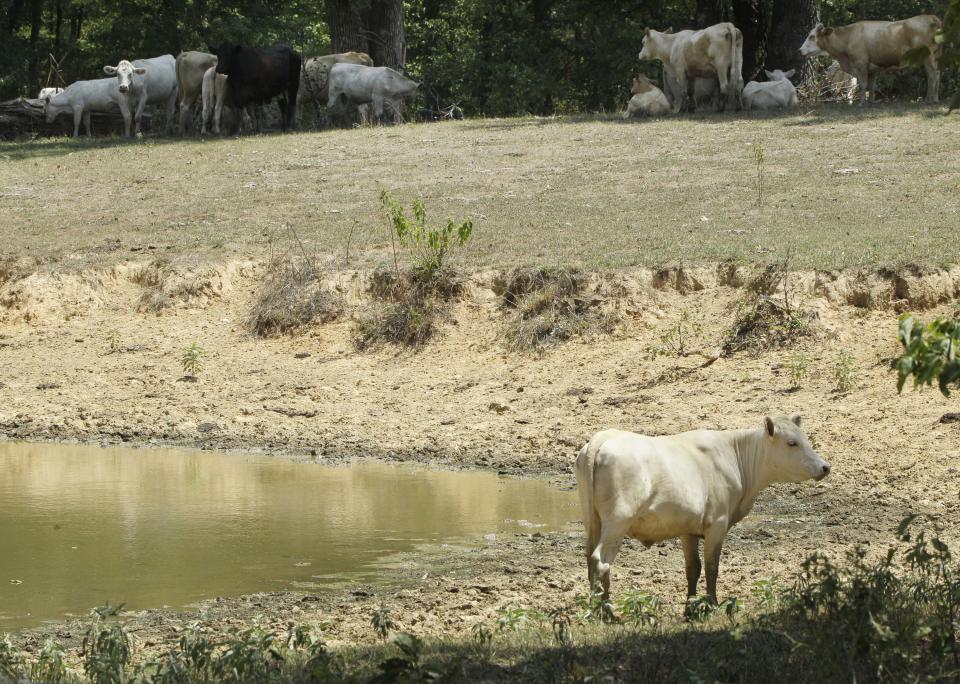Ponds, streams lose water fast in high Ark. temps
LITTLE ROCK, Ark. (AP) — The ponds on W.A. Blackmon's cattle ranch in central Arkansas are less than half full, and he figures he has water there for another 30 to 40 days. The ponds have been evaporating at a rate of 2 to 3 inches a day as temperatures soar past 100 degrees.
With drought covering two-thirds of the nation, Blackmon is living in one of the hardest hit areas. Perry County, like much of Arkansas, is in an exceptional drought, the worst of four stages listed by the U.S. Drought Monitor.
Most of the state is at an extreme risk of wildfires, and the Arkansas Forestry Commission sought help Tuesday from the Arkansas National Guard, which sent Black Hawk helicopters to help fight a fire at Mt. Riante. Officials statewide are keeping an eye on rivers and reservoirs, and farmers are doing their best to save livestock and crops amid extreme heat.
Still, Arkansas was slightly cooler than Monday, when Little Rock hit a record 111 degrees. The high Tuesday was 107. Pine Bluff reached 106 degrees and Harrison reached 100 degrees.
Blackmon, who has about 250 head of cattle, has already sold his calves. But he is more fortunate than some, with a flue on his property that will pull up some underground water if his ponds go dry. He was at a cattle sale barn Tuesday, and others "are liquidating cattle at farms that have been there a lifetime," he said.
"I pray for rain every day," Blackmon said. "You know what they say, 'Every day you get closer to the next rain.'"
Some chicken farmers also are running into water issues. Along with water for the birds to drink, many have cooling systems that use water to help keep the temperature down.
A poultry house with nearly mature birds can use 16 to 18 gallons per minute, said Susan Watkins, a professor and extension specialist at the University of Arkansas' Center for Poultry Excellence.
Multiply that by six to 10 houses and water usage can quickly add up," she said, although she noted some farmers may use less water at night, when the lights are out and the birds are sleeping.
Bruce Tencleve, poultry division coordinator for the Arkansas Farm Bureau, said all but a few of the state's 6,000-plus poultry growers have backup plans for getting water during the hot summer months.
Most also have converted their broiler houses so that they can be cooled with a tunnel air system, which moves cool air from one side of the barn to the other. About 15 years ago, before widespread conversion, the heat killed a lot more chickens than it does now, he said.
Some producers have lost a few birds to the heat, he said, but not many.
"It's not as cool as you may want it to be if it's 110 degrees outside ... but it's probably 20 to 25 degrees cooler. When you lower (the chicken house temperature) by a fourth, it's important," Tencleve said.
Arkansas reservoirs are not at a critical stage, although shortages could be possible later, the National Weather Service said. But some rivers are running dry.
The White River near Fayetteville was at less than one-tenth of its normal level for the day, said Nicole McGavock, a hydrologist with the National Weather Service in Tulsa, which covers northwest Arkansas. Many other rivers and streams are in similar straits.
At Georgetown in eastern Arkansas, the White River was at less than a foot on Tuesday and that didn't even put the river in the 10 lowest readings in the state, added Matthew Clay, forecaster for the weather service's office in North Little Rock.
"The rivers are normally five to six times (deeper) than they are now," Clay said.
Water is evaporating more quickly from soil, lakes, streams and ponds in the low humidity, McGavock said.
"It also causes additional stress on plants. They give off water vapor too. Low humidity causes greater loss through their leaves. In return, plants try to draw more water out of the ground," she said. "It's all connected."


